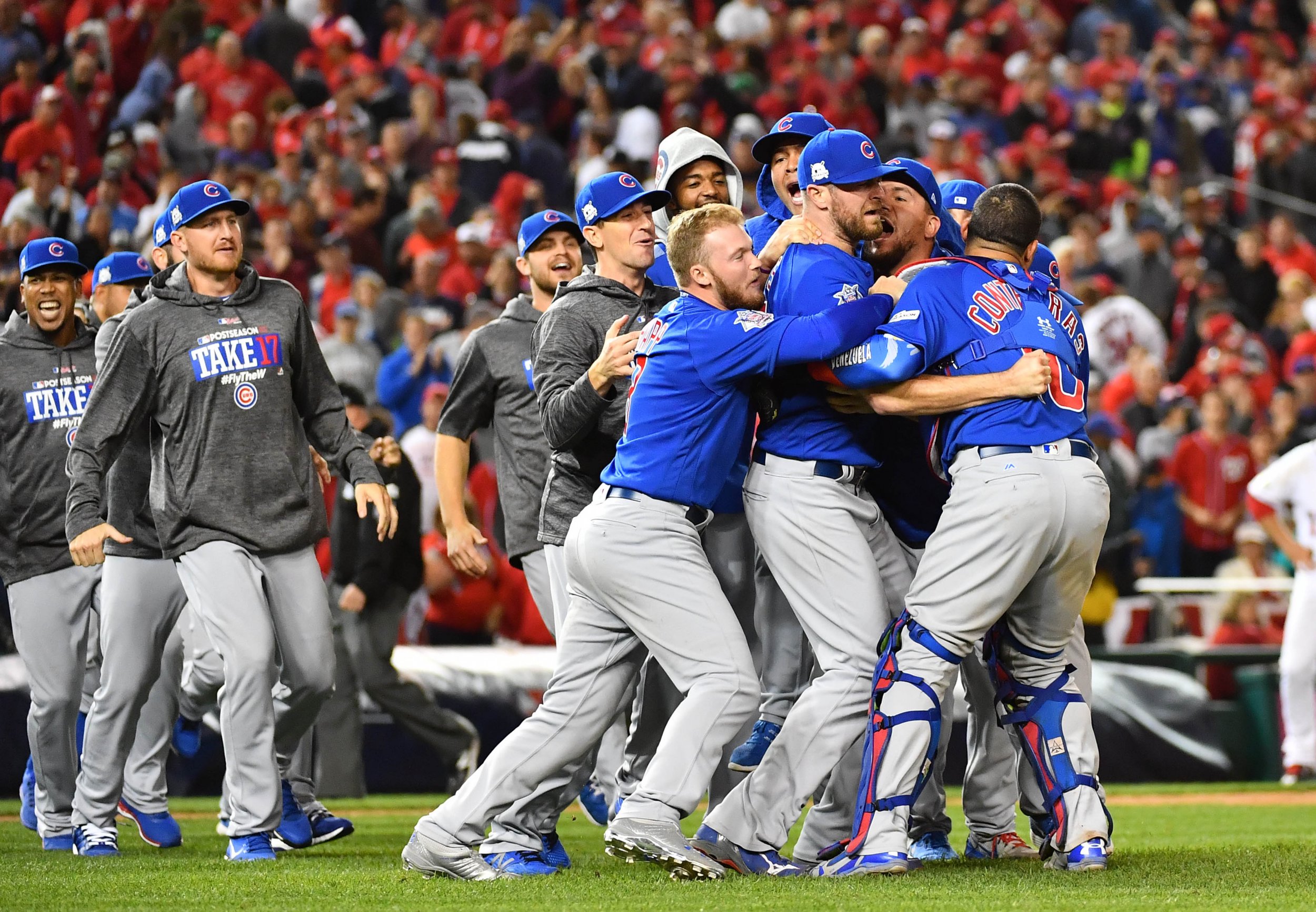
On Thursday evening (and Friday morning) the Chicago Cubs and Washington Nationals partook in an elimination game that lasted four hours and 37 minutes. By contrast, last summer's solar eclipse lasted, from West Coast to East Coast, four hours and four minutes. Should it really take less time for the moon to move past the sun than for the Cubs to move past the Nationals?
Video replay is not the only cause of interminable games, nor is that added time the primary reason it needs to be abolished. The reason Major League Baseball needs to give a "Yer Out!" to video replay is that it fails to address the problem it was designed to eliminate—an error-free game in terms of umpiring—while both delaying play and dehumanizing the national pastime.
Let's look at Game 5 from Nationals Park. With two outs and two Cubs on base in the top of the fifth inning, Javier Baez swung and missed and struck out. The ball, however, skipped under the glove of Nationals catcher Matt Wieters, who then made an errant throw past the first baseman. One Cub scored on the play, and two batters later in an inning that was extended by Wieters's error, a second Cub scored.
Two unearned runs, and the Cubs now had a 7-4 lead. Except that, by the rulebook, Baez's strikeout should have ended the inning. How come? Because on his errant swing, his bat struck Wieters' facemask. Part of one of the game's plethora of arcane rules, specifically 6.03, reads:
"If a batter strikes at a ball and misses and swings so hard he carries the bat all the way around and, in the umpire's judgment, unintentionally hits the catcher or the ball in back of him on the backswing, it shall be called a strike only (not interference). The ball will be dead, however, and no runner shall advance on the play."
After Wieters's throw sailed into right field, he turned to home plate umpire Jerry Layne to complain that Baez's bat had struck his facemask on the backswing. By the above rule, the ball should have been dead and the third out concluded the inning. Layne, however, missed the call and—here's the most important part—that play is not reviewable.
The two runs stood.
Three and a half innings later, it was the Nationals, trailing 9-8, who had two men on base with two outs. This time Cubs catcher Wilson Contreras fired the ball down to first baseman Anthony Rizzo in an attempt to pick off Jose Lobaton. The umpire extended both arms in a "Safe!" call but Chicago manager Joe Maddon challenged the call. After a couple of minutes and via the syncing of two camera angles that we viewers at home will just have to accept were perfectly aligned, in terms of time, a few men in a windowless room in lower Manhattan ruled Lobaton out.
Was it inexcusable for Lobaton to be picked off first with the tying run on second with his team trailing by one run in the bottom of the eighth of Game 5? Of course. But why was his play reviewable and Wieters's was not? That is, if the purpose of video replay is to eliminate errant calls by umpires?
A few years ago, I had a chat with a colleague, a nationally known college football writer, about instant replay/video review. I told him that I was against it in principle because not even cameras are able to eliminate the human condition, i.e., imperfection, from sports. Nor should they. He responded that he was in favor of instant replay because, "I just want them to get the calls right."
But they can't, because when all is said and done, nearly five hours after the home plate umpire cries, "Play ball!" (or four hours after the football referee blows the whistle for the opening kickoff), human judgment still intervenes. Last Saturday night, during the Alabama-Texas A&M football game, the Aggies scored a touchdown that went to video review. As we viewers were shown multiple inconclusive replays, the ESPN analyst admitted, "That's a tough angle."
The barrier to entry, supposedly, for all football video reviews is "irrefutable evidence." Simply by saying, "That's a tough angle," didn't the analyst just inform us that, whether or not we believed he Aggie player scored, "irrefutable" had, like Elvis, left the building?
Earlier this week, New York Yankees manager Joe Girardi, who has led the Bronx Bombers to one World Series title and has never had a losing season in his 10 years as manager, was excoriated for—what? Failing to pull a pitcher at the proper moment? Pinch-hitting for Aaron Judge? Nope. For failing to challenge an ump's call in Game 2 of the Yanks' series against the Cleveland Indians in which it was ruled that an Indian batter had been struck by a pitch?
To paraphrase Yogi Berra, who, like Girardi, was first a Yankees catcher and then a manager, "You can observe a lot by watching…the video monitor in your clubhouse."
A good friend of mine, a sports enthusiast who has been a scout for the Toronto Blue Jays for 17 years, recently suggested the "George Brett Rule of Visceral Reaction" as to where the bar should be set for video replay. "Remember how George Brett reacted when they called him out for having pine tar on his bat?" my friend asked. "That's how egregious a call should have to be for it to be overturned."
Mind you, my friend was not suggesting that the Brett call was wrong. He was simply using Brett's foot-stomping, I'm-this-close-to-slugging-ya' response to being called out back in 1983 at Yankee Stadium as the baseline for overturning bad calls. A more recent example, and one where instant replay would have saved a pitcher from being robbed of a perfect game: the safe call on the 27th consecutive out recorded by Detroit Tiger pitcher Armando Galarraga in 2010. No person possessed of vision is able to watch that play and consider the runner safe, even though first-base umpire Jim Joyce somehow did.
https://www.youtube.com/watch?v=ii_ve5GyF08
The inherent flaw in video replay is thus the slippery slope. One moment we are all sitting at home cursing Don Denkinger's incompetence (talk to a St. Louis Cardinals fan you know) in Game 6 of the 1985 World Series and the next we're all the Warren Commission poring over frames 311 to 314 of the Zapruder film.
On Thursday night—and Friday morning—in our nation's capital, 43,000-plus fans paid to watch 25 batters, 14 pitchers, six umpires and two managers participate in a baseball game. Not one of them played the most crucial rule in deciding the game. A nameless, faceless person in Manhattan did.
Video replay? Take it out of the ball game.…
Uncommon Knowledge
Newsweek is committed to challenging conventional wisdom and finding connections in the search for common ground.
Newsweek is committed to challenging conventional wisdom and finding connections in the search for common ground.
About the writer
John Walters is a writer and author, primarily of sports. He worked at Sports Illustrated for 15 years, and also ... Read more
To read how Newsweek uses AI as a newsroom tool, Click here.





